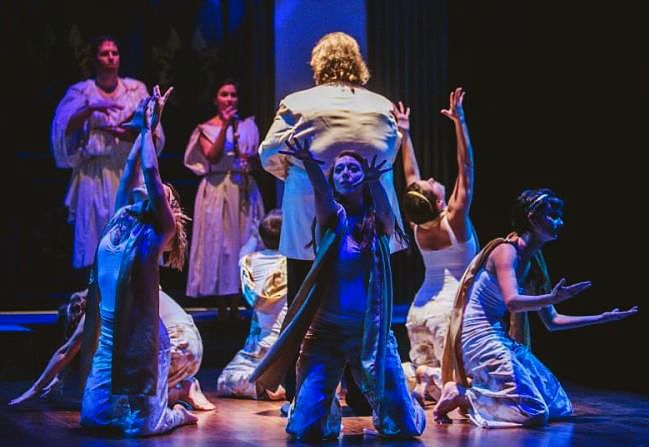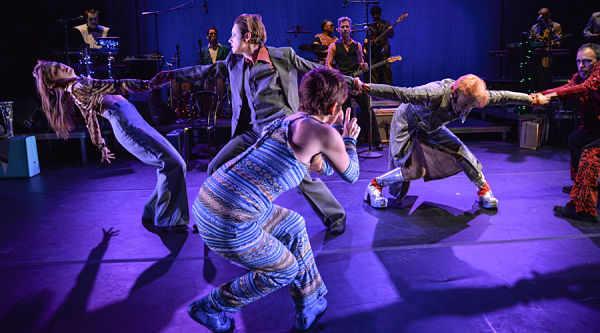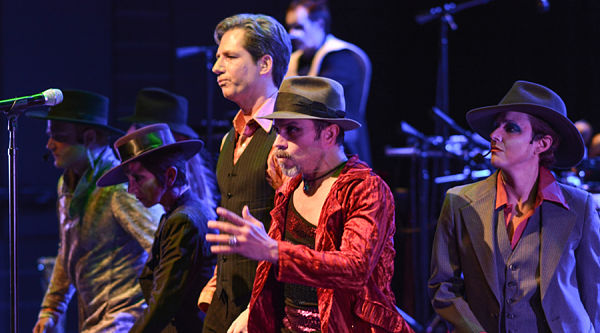21st Century Theatre: Texting and Gesturing the Future in Austin productions of DEUS EX MACHINA and THE BOWIE PROJECT
by David Glen Robinson
January
 A digitally obsessive audience, its thumbs working furiously, sits around a thrust stage in the Rollins Studio Theatre at the Long Center in Austin. Produced with The Fusebox Festival and Shrewd Productions, the play is Whirligig Productions’ Deus Ex Machina and the year is 2015. The audience members hurriedly text yes/no and either/or responses to prompts on a screen above suppliants at the stage Oracle of Delphi. The texts go to the number of “Zeus” given out before the show. Somewhere offstage a server tallies the texted responses each time the questions are asked. The tallied majority option becomes the answer given by the digital god in its renowned parlance of oracular mysticism. These answers turn the plot and set the fates of the characters—and also give plenty of piquant classical WTF moments to the audience. This certainly isn’t your sorority sister’s theatre anymore.
A digitally obsessive audience, its thumbs working furiously, sits around a thrust stage in the Rollins Studio Theatre at the Long Center in Austin. Produced with The Fusebox Festival and Shrewd Productions, the play is Whirligig Productions’ Deus Ex Machina and the year is 2015. The audience members hurriedly text yes/no and either/or responses to prompts on a screen above suppliants at the stage Oracle of Delphi. The texts go to the number of “Zeus” given out before the show. Somewhere offstage a server tallies the texted responses each time the questions are asked. The tallied majority option becomes the answer given by the digital god in its renowned parlance of oracular mysticism. These answers turn the plot and set the fates of the characters—and also give plenty of piquant classical WTF moments to the audience. This certainly isn’t your sorority sister’s theatre anymore.
 A few weeks later in the same theatre, Andrea Ariel Dance Theatre mounts a second edition of its acclaimed The Bowie Project 2: A Rock and Roll Soundpainting (The Bowie Project for short). Working from a tiered stage with musicians, actors, and dancers, three conductors, or “composers” take turns directing their artful performances. The composers work strictly in the moment, in a complex language of gestures all the performers have learned, and using agreed-upon “palettes” of material. The palettes in The Bowie Project 2: A Rock and Roll Soundpainting are each a song from David Bowie. The musical, acting, and dancing segments based on each palette altogether form a unique memoir of a Bowie song. Longtime Bowie fans hear his music in new ways, and the improvisationally composed movement and music ensure that no two performances of this show are the same.
A few weeks later in the same theatre, Andrea Ariel Dance Theatre mounts a second edition of its acclaimed The Bowie Project 2: A Rock and Roll Soundpainting (The Bowie Project for short). Working from a tiered stage with musicians, actors, and dancers, three conductors, or “composers” take turns directing their artful performances. The composers work strictly in the moment, in a complex language of gestures all the performers have learned, and using agreed-upon “palettes” of material. The palettes in The Bowie Project 2: A Rock and Roll Soundpainting are each a song from David Bowie. The musical, acting, and dancing segments based on each palette altogether form a unique memoir of a Bowie song. Longtime Bowie fans hear his music in new ways, and the improvisationally composed movement and music ensure that no two performances of this show are the same.
How can these two popular productions, both drawing on the past, seem so unusual and forward-looking? A related broader question rises conversationally among performing artists and audiences, entre nous and in public, on the future forms of the performing arts, or, What Is the Next Big Thing?
More than a century ago, the composer Wagner had that same thought and offered answers to the question. To him, opera was the ultimate art form, especially his own operas. Wagner’s argument was built on opera’s conjoining of all the highest art forms—music, theatre, literature, and every domain of visual art; all blended together to tell an inspiring musical story—often drawn from myth--on stage. Later, Camille Paglia insisted that cinema was the dominant art form of the 20th century. And cinema too, for all its well-deserved status as a new departure in the arts, was built on preexisting forms—storytelling, playwriting, period costumes, sculptural sets, symphonic scores, drawn and painted animated features, etc.
That was then, this is now. We the art-struck are still asking the questions, still attending the theatre, movies, symphonies, ballets, and operas. We search for the new and often settle for the merely innovative.
Can we truly perceive a new thing? It seems in the arts that the blending and reworking of old forms often benefits from new wrinkles in technology and shifts in aesthetics, and thus we shuffle toward newness or uniqueness. For many, this whole bundle of questions gained heightened interest some years back at the turn of the millennium, and now many folks actively seek the emergence of the new. Only that which sparks the popular imagination will stand the test of time. The two Austin productions mentioned here are offered as candidates for having such future-forward potential. No doubt other artistic groups in Texas are making similar efforts, and their work deserves highlighting as well.
Deus Ex Machina

Whirligig Productions’ Deus Ex Machina is a reimagining of the Greek Oresteia, treated by more than one ancient Greek playwright. The work deals specifically with Orestes’ return to Argos after the Trojan War with all the tragedy that entailed. Playwright Liz Fisher wrote approximately six hours of material for the show to account for twelve major storylines. Given the text choices to be made by the audience, the math works out to 12,288 distinct plot branches or combinations that may be explored. Think of a branching decision tree that creates a pathway of choices. Better yet, think of a gnarled live oak tree with its trunk, branches, limbs, and twigs all fractal cellulose curling and twisting into infinity. That’s what the plot of this Greek-drama-drenched show is like, fired with all the beauty and power of the audience’s collective imagination. As Fisher writes to the audience in her director’s notes in the show program: “From its inception, the story was crafted around the idea of empowering the audience to choose….so it seems natural to return to agency as an answer to weighty questions. This play cannot exist without you. Without your voice, the play stops.”
Co-artistic director Robert Matney designed the audience’s text option system, working with consultant Benjamin Bradley. The challenges of the technology lay in taking responses, data, from the cell phone system, inputting and processing the data on computers, and then using the internet to convey results back to the theatre screens and sound system. The whole thing not only had to work in real time, it had to be seamless as a theatrical presentation. The technical complexities are almost as intricate as Argolid politics, but this eye-witness reviewer vouches for its success.
The Bowie Project 2: A Rock and Roll Soundpainting

Andrea Ariel Dance Theatre’s The Bowie Project is far less technical than Deus Ex Machina, but it blends art forms—music, dance, and theatre—improvisationally by a 1200-gesture sign language developed by musician and composer Walter Thompson. Whereas Wagner and all operatic composers attached all the art fields in composite fashion to a central story/music plotline, Soundpainting calls on all its art fields democratically as equivalent material across all disciplines; here the arts are each like mixed-in color chips in a kaleidoscopic image, all changing shape as the performance turns while remaining recognizable. In the show, artistic director Andrea Ariel is one of the three performing composers. She gives gesture commands to the musicians, actors, and dancers. They all play music, act, and dance. But viewing the show altogether, one sees—or feels—that the show is not merely a concert, a play, a dance show, or a discordant mash-up of all three. The performance seems to achieve an organic synthesis, the look of something one might call new.
By use of the palette material, The Bowie Project clings to its theme of David Bowie, and audience fans enjoy its differing takes on the rock star. To say the show is a deconstruction of David Bowie and his art is refreshingly true. It reflects the fractured reality of the pop musician who switched out his performance personae almost weekly, it seemed, and also suffered serious identity problems in his personal life. The literal truth is that no two performances of a Soundpainting show are remotely similar. The deep potential of Soundpainting is that it offers the capability of breaking apart a vast number of themes in the arts and wider culture and giving them back to audiences in creative and fascinating ways.
Comparisons
 These well-produced shows offer two bright examples of the Austin independent arts scene, and direct comparisons are in order. First, whereas Deus Ex Machina has calculable variants and guidance through its branching tree plot, The Bowie Project does not; the show’s progress is limited only by the improvisational imagination of the composer. Also, the two shows contrast greatly in their approaches to performance. In its stage progression, Deus Ex Machina proceeds from a traditional core of stage mechanics and clearly identified characters engaging in dialogues and orations. Playwright Fisher scripts the plot options, and they are rolled out on stage once chosen by the thumb-happy audience, but some devised work is probably necessary when the segments do not match exactly. The Bowie Project is unscripted beyond the content of the musical palettes, and every figure on stage is a persona or character of David Bowie. The actors offer dialogues from the palettes, drawn from the numberless interviews, lyrics, and biographies of the pop star, but only when cued by the composer. In Deus Ex Machina, dance and music were choreographed and composed for the show well ahead, but in The Bowie Project they were created and directed on the spot per the standards of the Soundpainting gesture language.
These well-produced shows offer two bright examples of the Austin independent arts scene, and direct comparisons are in order. First, whereas Deus Ex Machina has calculable variants and guidance through its branching tree plot, The Bowie Project does not; the show’s progress is limited only by the improvisational imagination of the composer. Also, the two shows contrast greatly in their approaches to performance. In its stage progression, Deus Ex Machina proceeds from a traditional core of stage mechanics and clearly identified characters engaging in dialogues and orations. Playwright Fisher scripts the plot options, and they are rolled out on stage once chosen by the thumb-happy audience, but some devised work is probably necessary when the segments do not match exactly. The Bowie Project is unscripted beyond the content of the musical palettes, and every figure on stage is a persona or character of David Bowie. The actors offer dialogues from the palettes, drawn from the numberless interviews, lyrics, and biographies of the pop star, but only when cued by the composer. In Deus Ex Machina, dance and music were choreographed and composed for the show well ahead, but in The Bowie Project they were created and directed on the spot per the standards of the Soundpainting gesture language.
 Deus Ex Machina required ongoing audience participation through its decision making and texting of oracular options to Zeus. The audience literally controlled the twistings and turnings of the plot. Audience participation in The Bowie Project was much less, but it followed the general improvisational scheme. Knowing that many in the audience would treat the gesture language they were watching like a game of riddles or a rebus, the active composer would turn occasionally to the audience and give gesture commands: “laughter,” “higher/lower volume,” “decrease/increase tempo,” “stop,” and others. Those who had figured out the commands responded accordingly. Besides keeping the audience on its toes, this activity gave the audience a strong sense of joining in the artistic transaction. After the curtain call, too, the audience was invited to dance in a three-song set of Bowie songs by the musicians, who at other times form the Bowie cover band Super Creeps, led by guitarist and singer Adam Sultan.
Deus Ex Machina required ongoing audience participation through its decision making and texting of oracular options to Zeus. The audience literally controlled the twistings and turnings of the plot. Audience participation in The Bowie Project was much less, but it followed the general improvisational scheme. Knowing that many in the audience would treat the gesture language they were watching like a game of riddles or a rebus, the active composer would turn occasionally to the audience and give gesture commands: “laughter,” “higher/lower volume,” “decrease/increase tempo,” “stop,” and others. Those who had figured out the commands responded accordingly. Besides keeping the audience on its toes, this activity gave the audience a strong sense of joining in the artistic transaction. After the curtain call, too, the audience was invited to dance in a three-song set of Bowie songs by the musicians, who at other times form the Bowie cover band Super Creeps, led by guitarist and singer Adam Sultan.
The most obvious forward-looking element in Deus Ex Machina is its embrace of digital and cell technology. It must be said that many other productions in recent memory have used cell technology to allow audience members to phone in pertinent information to the production. Another Fusebox production, Computer Simulation of the Ocean by Steve Moore, was a play (and a truly powerful one) entirely in the form of text messages sent to the phones of subscribers. The difference with Deus Ex Machina is that in the Greek-themed play responses of the audience via the cell system are integrated with the production and are essential to it; they change the story and its outcomes. Aficionados can and do imagine some kind of link-up of cell technology, virtual reality, and Greek drama farther on down this pathway.
The Andrea Ariel Dance Theatre uses Soundpainting to create never-to-be-repeated performances of great satisfaction to audiences that seek new artistic experiences and shun repetition. At the same time, Soundpainting has a supreme ability to explore profound themes that speak to people on deeper levels. This is a quality that gives a future to all art in all times.
Both of these productions take a notable backward glance, Deus Ex Machina to classical Greek drama, and The Bowie Project to 70s pop music. Here is a common structural element that gives audiences of both shows something familiar, perhaps comforting, while being led through unfamiliar and uncharted waters. Could those waters be Plato’s artistic sea of madness?
Both shows were well attended in Austin, and audience popularity often contributes to passing the ever-dreaded test of time. Soundpainting is popular in Europe in performance and teaching, and in North America it awaits only the advent of composers trained in Soundpainting to produce shows. Liz Fisher of Whirligig Productions plans to bring back the company's successful marriage of technology and performance in Deus Ex Machina at some unannounced date. That reappearance is eagerly awaited by those who have attended its shows.
POSTSCRIPT. The technical team of Deus Ex Machina, Benjamin Bradley, Robert Matney, and Tim Thomas, received a Special Recognition Certificate for “outstanding technical achievement” from Austin’s B. Iden Payne Awards committee at their annual Austin awards ceremony on October 26, 2015.
Deus Ex Machina
by Liz Fisher
Whirligig Productions
January 3 - 18, 2015
Wednesdays - Saturdays at 8 p.m., Sundays at 5 p.m.
Pay what you can Preview on January 2; Industry night Monday January 12
Tickets available at http://thelongcenter.org/ or by calling the 3M Box Office at (512) 474-LONG (5664), TTY (800) 735-2989
